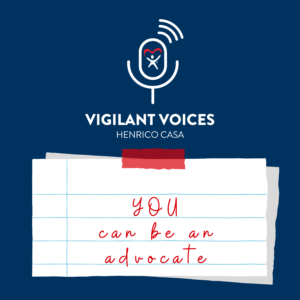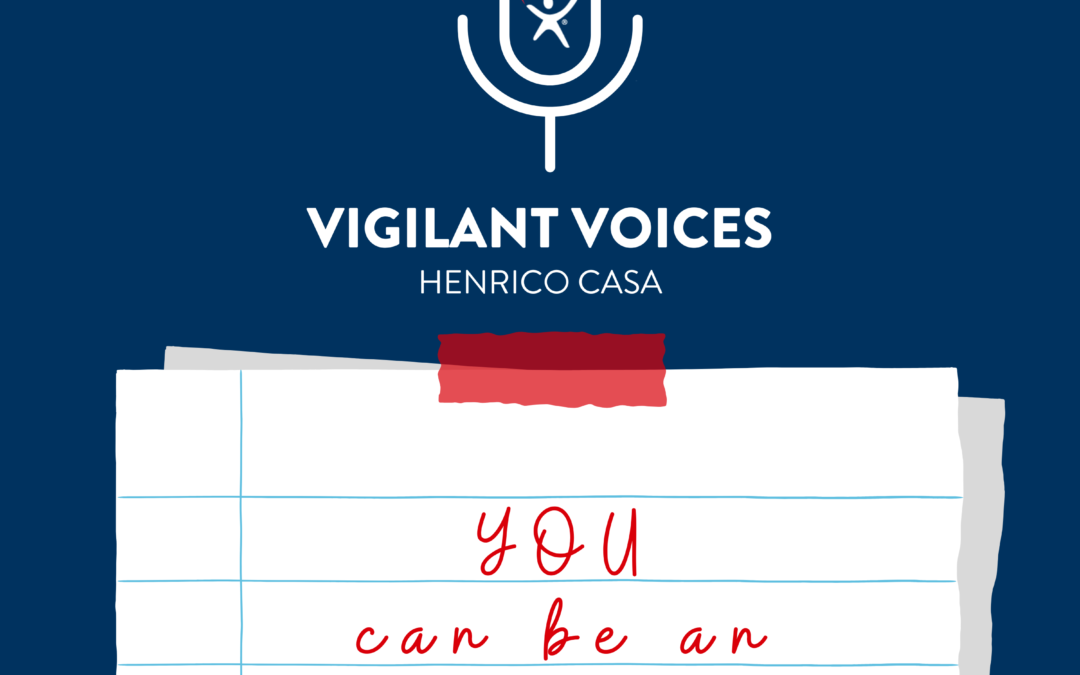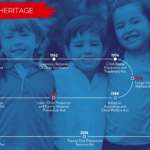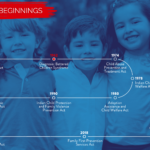
Listen to Episode 2 of the Vigilant Voices™ podcast, You Can Be an Advocate.
Jeannine Panzera: Hello, listeners. You are listening to our brand new Vigilant Voices podcast. And we’re glad you’re here.
Kristin Blalock: We are. You know, in our work at CASA, Court Appointed Special Advocates, we’ve learned that it’s important to KNOW about the challenges facing children and families to ensure that NO child faces abuse, neglect, or trauma. And that’s what our new podcast is all about.
J: Okay, so, listeners, I’ve got a question for you that I want you to think about. And Kristin, I’m going to ask you the same. What do you picture when you think of the word advocate?
K: I know that I never used to picture myself, but I think that was before I really understood what advocacy was. I had, like, a picture in my head of people, like, picketing on the courthouse steps or something, and that didn’t feel like me. I’m kind of a reserved, quieter person.
J: I get that. And I think that that is probably what a lot of people think about when we see people marching for causes that they believe in. So hang around until after our CASA story, and you may see that the image that we conjure in our minds just may be a little bit different. And there are three sort of main categories of advocacy, and we really believe that we can all fit into at least one of them.
K: Okay, so let’s jump into our CASA story. I wanted to tell you all about a teenager who we’re going to call Alex. We met Alex when he was recovering in a mental health treatment center after trying to take his own life, which is heartbreaking. Alex was just he was in such a vulnerable place and needed so much love and support. He had a history of self-medicating and self-harm. If that’s not a term you’re familiar with, think of things like cutting, but he was basically putting out these cries for help that were really heartbreakingly, not loud enough for his mom to hear because she was battling her own demons.
J: Yeah, this is a tough situation for this child, and it’s really difficult when we see these types of cases because we’re seeing a huge rise in mental health crises, really, in our entire country for everyone, but especially our youth. One in three teens are experiencing some type of anxiety disorders, which is just a huge increase from just really a few years ago. And suicide is now the number two cause of death for young teens. I can’t even wrap my head around that. And so it really is just a clear sign to me that we really do have a mental health crisis for our children. But I also see this story as potentially leading into a conversation about a type of advocacy. We mentioned three, but one is called self-advocacy. And just I guess as a very simple definition, that’s just the ability to communicate your own needs, which sounds so simple, right?
K: I wish it was. And it’s probably easier for those of us who grew up in healthy households because we kind of learned this from day one. As babies, we cried, right? And our parents responded with whatever we needed and there was this positive back and forth. So we learned when we cry and convey what we need. And then later on we learned how to use words to convey what we need. Our parents met our needs.
J: We actually called that a ‘serve and return.’ If you think about tennis, someone serves and then someone returns if the game is being played well and it’s a sign of healthy development. That’s right. So then of course the other side of that though is what about our children that are growing up in maybe not so safe environments or not so healthy environments? And then it becomes a lot more complicated and not quite as simple. They’re not being heard. Those needs are not being met. And over time, they don’t even know that they’re supposed to voice those needs or what’s the point? Because they’re not actually being heard. It’s so sad. And so in this particular scenario, when we have a child like Alex, who is self-medicating, self-harming, and attempting to take his own life, those are extreme measures, but very clear cries for help. And unfortunately, they weren’t being heard.
K: We all want to be seen and heard, right? And luckily, even for those of us who didn’t learn it through child development in kind of a typical fashion, self-advocacy is a skill that can be taught. And so if it isn’t developed naturally or through a healthy connection with a safe adult, all hope isn’t lost, right? And at any age we can learn to advocate for ourselves.
J: I’d probably say the most difficult aspect might be that it requires some vulnerability, right? And for those listeners who may be very familiar with Brene Brown, I have a very high regard for her. She’s a professor, author, and podcast host. And she’s really known for her research on leadership, but also vulnerability. And what she says is that vulnerability is not weakness, it’s actually our greatest measure of courage.
K: Truth. And I feel like once we master advocating for ourselves, it’s only natural to want to advocate for others. And that would be the second type of advocacy that we wanted to share with everyone today. The first was self-advocacy. The second is individual advocacy. And I looked up the definition of this for a recent blog post I was writing.
J: Wait a minute, wait a minute. Is that just like your quick way of plugging our really great blog?
K: Maybe?
J: That’s fine. Well, okay, listeners, so good to know. We’re definitely going to share this in our notes in terms of how to connect with us and see more work that we do on our blog and in writing. But we really do share a ton of content about our work as Court Appointed Special Advocates and issues that kids who have experienced abuse and neglect are facing.
K: Yeah. Okay. So the definition I found says that an individual advocate is “one who pleads on someone else’s behalf.” And I guess when I was saying I didn’t consider myself an advocate, at some point, I realized I was doing this left and right with my own kids, especially at school with things like IEPs and 504 plans. So as I was calling counselors and following up with people, I kind of stumbled upon the truth that I am, in fact, an advocate. It’s not just standing on the steps of the Capitol building. It’s persistently calling the school counselor to follow up on things. It’s explaining to people why your child needs X, Y, and Z. It’s coordinating care with a bunch of professionals.
J: Right. And it’s a big conversation that I’m always sharing when I meet with individuals in my role as the Director of CASA, that we are advocating for children who have experienced abuse and neglect. And ideally, we want parents to fill that role. But sometimes, like we talked about in our last episode, there are struggles and they’re not able to do so. And that’s where we step in. And so then our advocates are consistently and proactively speaking up for these children and for their needs in the court system and the child welfare system. And so we train our advocates, who are volunteers, to be steadfast in their work with these children. They are speaking up on behalf of the child, speaking up for those needs, whether it’s at school, like you mentioned right, the IEPs, or in the community. And while it sounds lofty, it really is exactly what you described of just thinking about those children and what they need every day.
K: Steadfast is the perfect word. It’s all about just being dedicated, right. And following up to make sure a child isn’t overlooked or lost. Because we all know the systems are so overburdened.
J: Right. So, at CASA, we often use phrases when we do outreach just to kind of put perspective for folks, is that we’re giving children a voice. Right? But the reality is that children have a voice, but depending on their age, depending on their developmental skills and level, we just make sure that it is heard because we know the child and know those needs and have the ability to bring it forward.
K: Right. There are so many needs that children have. There’s the baseline physical need like food and shelter, right? But beyond that, they’ve got mental needs, developmental and emotional needs, social needs, educational needs. I mean, the list can go on and on. And some of those needs are easy to put into words, but others are abstract and the kids don’t even know it’s a need or something that would benefit them.
J: Right. Some of the baseline needs that you’re mentioning, what we would consider minimally sufficient for children to have, those are the day to day individualized type of needs. But then we do have systems in place that try to move things forward. And that’s where then we have what we call macro level, highest level advocacy. And a lot of the way that we describe it here is what we would call systems advocacy and change. And that’s then that third category of advocacy. And we do need people to speak up for that systemic change to make those large differences. And I think, Kristin, if I’m thinking right, even though we’ve talked about these first two, that this third level is probably where you had that idea originally of, okay, the marches, the picketing.
Exactly. That’s where that would come into play. And that does happen. But that’s really not the only way to approach systems advocacy. But this is something you’re probably more familiar than me with just because of your experience with the legal field.
K: I am. Because when we think about all of these systems, a lot of it is driven by the law. But we have to remember that the law comes from federal initiatives, from state initiatives. All of that trickles then down to what actually happens in individual communities, what we see. And so it very much is what we call that trickle down of we might have the federal laws and regulations that then states adopt that may make some changes that then becomes relevant to their citizens.
J: And then we do the same then at more local levels. And you could argue that the work that we do in our county is even grassroots, working directly with the citizens and the children and families that we see and advocate for daily.
K: Yeah, that’s true. There’s kind of that top down advocacy or systems right. But this type of advocacy is really about anything beyond just an individual. So it’s policies, not just at a government level. It’s groups of neighbors seeking change in their HOA. It’s parents or teachers improving the education system through a PTA. Those are both ways I know I’ve been involved in what I would call systems advocacy.
J: Absolutely. And we need those types of movement right, to make those changes, to improve the neighborhoods, to improve education. And for us then speaking directly to the child welfare system and thinking about the needs of children. Gosh, there are so many organizations in our area that do great work. And I’m thinking of a great collaborative partner with CASA is Voices for Virginia’s Children and they do wonderful work for Virginians and our most vulnerable citizens being children at the legislative level. They’re just right there with the General Assembly really helping to inform and educate. So our delegates and our senators really understand the needs of children and families so that we can make the right decisions and the right laws at that system level to make a change, right, and to prioritize the wellbeing of kids exactly all around.
K: Okay. Those were the three types of advocacy. Again, it was the self-advocacy, individual, and then also systems level. So let’s go back to Alex’s story, which we started with and kind of talk about how we were able to advocate for Alex because he wasn’t able to advocate for himself in a safe, healthy way. Right, so he hadn’t learned healthy self advocacy yet and his parents weren’t present to be able to advocate for him. So his dad had been in prison and his mom was living out a cycle from her own childhood and her own parents. She had grown up in foster care and generational trauma. She herself had never learned to advocate for herself. So she had grown into an adult who couldn’t advocate for her own adult needs. And so that’s when CASA was stepping in. And Alex’s CASA advocate listened and listened well. So she was able to not only advocate for Alex’s needs and wishes, like where he wanted to live and with whom, but she could also help advocate for his mom’s needs. She helped them both find services and supports and in the end they were able to move forward together as a family unit, knowing that they could speak up for themselves and that they didn’t have to face challenges on their own.
J: I love that example because it kind of shows where CASA has such an important role with children and families. Because while we are tasked with advocating for the best interests of the child, we are also connecting families with services to assist them because we know that if children are with their families, that’s best for them and that would be a best interest type of advocacy if we can see and help encourage those changes. And so really, thanks for sharing, but a great example of, I think, how self advocacy can really be taught and nurtured and developed really at any stage in life.
K: And I hope we can all remember that that’s kind of the first step. Right? Self-advocacy is the precursor to becoming an advocate for others, whether it’s at an individual or macro/systems level.
J: And so that’s our call to action for you, our listeners. This week we’ve discussed three types of advocacy which we’ve recapped a few times. So let’s try to put that first one into action. Think about how you might advocate for yourself, voice a need that you might have, whether that’s to your parents, your spouse, a friend, a teacher, like, whomever that person might be in your life, and just take that step of thinking about what that might be and then speaking up and sharing and being vulnerable.
K: Remember, it’s okay to be vulnerable. Right? We’re all human. We all have needs. We would live in what would probably be a much more gentle culture if we were all willing to admit that. Right? And learning to speak up for yourself will help you model self-advocacy to the children and anyone else, honestly, who is important in your life. And it will help hone their ability to advocate for themselves, which










